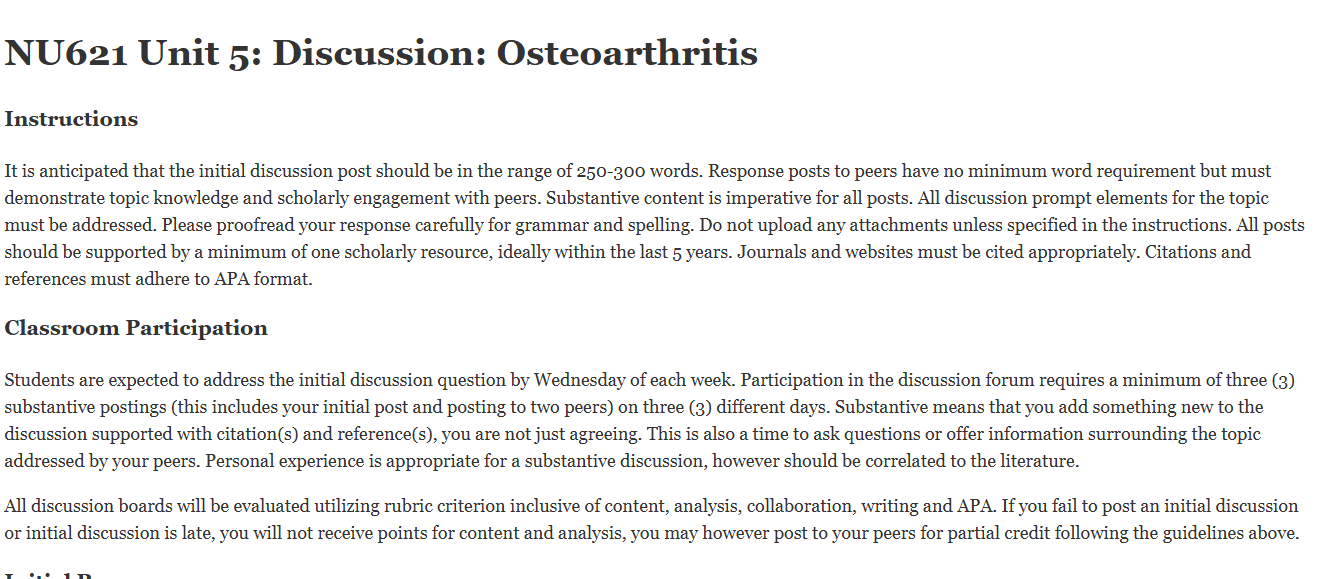NU621 Unit 5: Discussion: Osteoarthritis
Instructions
It is anticipated that the initial discussion post should be in the range of 250-300 words. Response posts to peers have no minimum word requirement but must demonstrate topic knowledge and scholarly engagement with peers. Substantive content is imperative for all posts. All discussion prompt elements for the topic must be addressed. Please proofread your response carefully for grammar and spelling. Do not upload any attachments unless specified in the instructions. All posts should be supported by a minimum of one scholarly resource, ideally within the last 5 years. Journals and websites must be cited appropriately. Citations and references must adhere to APA format.
Classroom Participation
Students are expected to address the initial discussion question by Wednesday of each week. Participation in the discussion forum requires a minimum of three (3) substantive postings (this includes your initial post and posting to two peers) on three (3) different days. Substantive means that you add something new to the discussion supported with citation(s) and reference(s), you are not just agreeing. This is also a time to ask questions or offer information surrounding the topic addressed by your peers. Personal experience is appropriate for a substantive discussion, however should be correlated to the literature.
All discussion boards will be evaluated utilizing rubric criterion inclusive of content, analysis, collaboration, writing and APA. If you fail to post an initial discussion or initial discussion is late, you will not receive points for content and analysis, you may however post to your peers for partial credit following the guidelines above.
Initial Response
Instructions:
Osteoarthritis (OA) is the most common form of arthritis and a leading cause of disability worldwide. It is characterized by the progressive degeneration of joint cartilage, subchondral bone changes, and synovial inflammation. The condition often affects weight-bearing joints, such as the knees, hips, and spine, but can also impact the hands and other joints.
For this week’s discussion, explore the pathophysiological mechanisms underlying osteoarthritis. Consider the following questions to guide your response:
- Discuss the role of mechanical stress, inflammation, and cartilage degradation in the progression of osteoarthritis.
- How does aging contribute to the development of OA? What other risk factors (e.g., obesity, genetics, joint injury) play a significant role in the disease process?
- Compare and contrast the normal physiology of articular cartilage with the pathologic changes that occur in osteoarthritis.
- What are the systemic and local effects of inflammatory mediators (e.g., cytokines, matrix metalloproteinases) in the progression of osteoarthritis?
- How do changes in the subchondral bone, synovium, and surrounding tissues contribute to the clinical manifestations of OA, such as pain, stiffness, and limited mobility?
Be sure to integrate current research, pathophysiological principles, and clinical implications into your discussion.
Responses need to address all components of the question, demonstrate critical thinking and analysis, and include peer-reviewed journal evidence to support the student’s position.
Please be sure to validate your opinions and ideas with citations and references in APA format.
Your initial response is due by Wednesday at 11:59 pm CT.
Estimated time to complete: 2 hours
Peer Response
Instructions:
Respond to at least 2 of your peers’ posts. To ensure that your responses are substantive, use at least one of the following prompts:
- Expand on a specific point made by your peer and discuss how it relates to the broader pathophysiological mechanisms of osteoarthritis. How might this point influence future treatment strategies or research in OA?
- Compare and contrast your peer’s perspective on the role of inflammation or mechanical stress in OA with your own understanding. Are there additional factors or emerging concepts that should be considered in the discussion?
- Provide an alternative viewpoint or add new research findings that support or challenge your peer’s explanation of a particular risk factor (e.g., obesity, genetics) in the development or progression of osteoarthritis. How might these new insights shift the approach to managing OA?
Responses need to address all components of the question, demonstrate critical thinking and analysis, and include peer-reviewed journal evidence to support the student’s position.
Please be sure to validate your opinions and ideas with citations and references in APA format.
Please review the rubric to ensure that your response meets the criteria.
SOLUTION NU621 Unit 5: Discussion: Osteoarthritis
Hello Class,
Discuss the role of mechanical stress, inflammation, and cartilage degradation in the progression of osteoarthritis.
In osteoarthritis, everyday forces on the joints can become harmful when they are too strong or applied too often. Under normal conditions, articular cartilage, which is a smooth tissue covering the ends of bones, cushions the joints and helps them move without pain. However, when a joint is exposed to too much pressure or abnormal movements, the cartilage can develop tiny cracks and damage. This mechanical stress causes the cartilage cells, known as chondrocytes, to release enzymes like matrix metalloproteinases (MMPs) (Hunter et al., 2020). These enzymes break down essential parts of the cartilage, such as collagen and proteoglycans, which help the cartilage remain strong and flexible (Goldring & Goldring, 2021). With less collagen and fewer proteoglycans, the cartilage becomes softer and less able to handle everyday stress….
Kindly click the purchase icon below to buy the full solution at $5
(FINAL ANSWER) NU621 Unit 6: Discussion: Neurobiology of Mental Health Disorders

